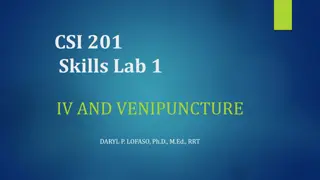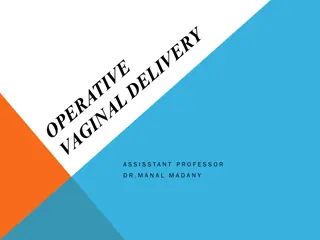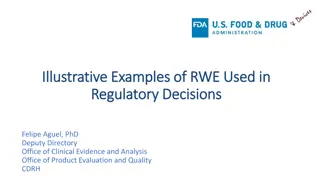UK Survey on Endovascular Treatment of Acute Pulmonary Embolism
Acute pulmonary embolism (PE) is a significant issue in hospitalized patients, with current treatments focusing on anticoagulation and systemic thrombolysis. Surgical treatments have shown poor outcomes, leading to a rise in endovascular techniques aimed at reducing clot burden. A survey conducted i
0 views • 12 slides
Advances in Trans-Catheter Aortic Valve Replacement: A Comprehensive Review
This presentation explores the evolution of Trans-Catheter Aortic Valve Replacement (TAVR), highlighting historical milestones, anatomical considerations, the role of Balloon Aortic Valvuloplasty, current guidelines, the need for TAVI, and a notable case study by Dr. Cribier. The content discusses t
2 views • 85 slides
Guidelines for Intensive Care Unit (ICU) Management by Dr. Zia Arshad
Dr. Zia Arshad provides comprehensive guidelines for managing patients in the ICU, including admission criteria, monitoring protocols, handling lab investigations, communication procedures, and post-mortem care. The guidelines emphasize meticulous documentation, compassionate patient care, infection
0 views • 28 slides
Central Venous Catheter Access Management in Brampton and Surrounding Areas
Nurse-led Outreach Team in Brampton, North Etobicoke, West Woodbridge, Malton, and Bramalea provides education on managing central venous catheter access devices like PICCs. Learn about preventing infections, post-insertion care, types of CVADs, and aseptic techniques for PICC line management.
1 views • 20 slides
Essential Guide to IV Procedure and Venipuncture Techniques
Learn about indications for IV access, common IV sites, IV catheter sizes, steps for performing IV procedures, risks of needle sticks, and measures to prevent them. This detailed guide by Daryl P. Lofaso, Ph.D., M.Ed., RRT provides valuable information on safely and effectively administering IV medi
0 views • 15 slides
Acute Respiratory Failure in ESRD Patients with Diffuse Bilateral Alveolar Infiltrates
In a 45-year-old male with end-stage renal disease (ESRD) and acute hypoxemic respiratory failure, diffuse bilateral alveolar infiltrates with air bronchograms were noted, including right mainstem intubation. Correct positioning and management steps for endotracheal tube placement were discussed. Ad
0 views • 4 slides
Central Venous Catheters: Uses, Placement, and Indications
A central venous catheter (CVC) is a crucial medical device placed into a large vein for various purposes like administering medication, fluids, and obtaining blood tests. The catheter can be tunneled or non-tunneled, and specific sites are preferred for each type. Indications for CVC usage include
1 views • 19 slides
Suprapubic Catheter Insertion Procedure Guidelines
Suprapubic catheter insertion is a procedure indicated for conditions such as urethral injury, obstruction, bladder neck masses, and benign prostatic hypertrophy. It involves proper patient positioning, analgesia, equipment preparation, and a step-by-step technique including bladder palpation, marki
1 views • 12 slides
Validation and Sterility Assurance in Packaging Systems: Key Considerations
This content discusses the requirements for validating packaging systems and ensuring sterility, presented by Hartmut Dunkelberg from the University Medical Center in Goettingen, Germany. Key topics covered include the validation of basic operations such as emptying catheter bags, risks of contamina
1 views • 28 slides
Guidelines for Assisted Vaginal Birth Delivery
Assisted vaginal birth using forceps or vacuum extractor is recommended in cases of suspected fetal compromise or maternal exhaustion. Indications include lack of progress during labor, maternal medical conditions, or combined factors. Full abdominal and vaginal examinations are necessary before pre
0 views • 21 slides
Massachusetts Health Care System Provider Quality Focus Chart Book
This chart book focuses on the performance of the Massachusetts health care system in terms of provider quality metrics such as hospital performance scores, patient safety, communication, medication management, and patient experience. It covers various aspects including surgical procedures, readmiss
0 views • 23 slides
Examples of Real-World Evidence in Regulatory Decisions by FDA
FDA showcases illustrative examples of how Real-World Evidence (RWE) has been utilized in regulatory decisions, highlighting its value across different submission types, data sources, and purposes from FY12-FY19. The FDA report features cases like a modified hemodialysis catheter end cap, tumor prof
0 views • 14 slides
Case Study: Recurrent Outflow Failure and Catheter Encapsulation in PD Patient
Case study of a 69-year-old patient with hypertensive nephrosclerosis experiencing recurrent outflow failure and encapsulation of a PD catheter. Initial difficulties with catheter placement led to multiple instances of pain on inflow/outflow, necessitating repositioning and replacement procedures. E
0 views • 10 slides
Management of Malignant Ascites in Advanced Cancer: ESDO Learning
Malignant ascites is a challenging complication of advanced cancer, impacting patient quality of life and survival. Diagnosis involves imaging and cytology, with poor prognostic indicators. Management includes symptom relief with diuretics, paracentesis, and catheter options. Refractory cases presen
0 views • 7 slides
Strategies for Preventing Catheter-Associated Urinary Tract Infections
Catheter-associated urinary tract infections are a common healthcare-associated infection, with 80% of hospitalized patients experiencing a urinary tract infection. This article provides guidelines for preventing CAUTIs, such as only catheterizing patients when necessary, maintaining asepsis, practi
0 views • 20 slides
Healthcare Safety Network Data & Analysis - Nevada HAI Task Force
This comprehensive dataset analysis conducted by the Nevada HAI Task Force provides insights into various healthcare-associated infections, including Catheter-Associated UTIs and C. difficile infections. The data comparison across different quarters offers valuable information for improving healthca
0 views • 8 slides
Enhancing Peritoneal Dialysis Options for Improved Patient Outcomes
Ensuring quality in peritoneal dialysis by providing patients with the choice between PD and hemodialysis leads to a flexible lifestyle, preservation of renal function, and potentially fewer complications. Nephrologist placement of PD catheters using a percutaneous method under local anesthetic prov
0 views • 17 slides
Preventing Catheter-Associated Urinary Tract Infections
This presentation covers the prevention of catheter-associated urinary tract infections (CAUTIs) in healthcare settings. It highlights the significance of urinary tract infections, risk factors, preventive measures, and common microbiology involved. Key topics include the importance of urine collect
0 views • 34 slides
Essential Nursing Concepts Review
This content covers a wide range of essential nursing concepts such as proper management of catheter bags, blood pressure reporting guidelines, application of elastic stockings, potential health issues post-surgery, diabetic foot care, elderly patient care, warm pack application, respiratory conditi
0 views • 30 slides
Comprehensive Role of CP-CPHC Team in Patient Safety Day Observance
The CP-CPHC team plays a crucial role in ensuring patient safety during observance days by providing home-based palliative care services such as back care, catheter care, and oral care. ASHAs identify patients in need and utilize home care kits. Training resources and skill videos are available on Y
0 views • 5 slides
Foley Catheter Care and Compassionate Practices
Providing guidance on the compassionate care and proper maintenance of Foley catheters is essential for healthcare staff. This presentation covers the identification of urinary tract infection symptoms, methods for maintaining catheter integrity, and ensuring patient comfort during turning and trans
0 views • 14 slides
Managing Catheter-Related Bloodstream Infections in Vascular Access
Reduce and prevent catheter-related bloodstream infections in vascular access by addressing extraluminal infection sources and implementing strategies outlined in national drivers such as the NHS Long Term Plan and the Antimicrobial Resistance Action Plan. Recognize the importance of tackling antimi
0 views • 25 slides





















